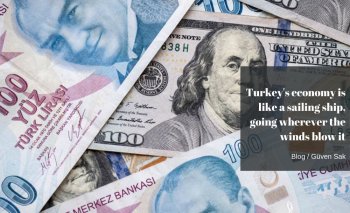Commentaries
Fatih Özatay, PhD - [Archive]
Society’s memory can sometimes be too strong 11/04/2010 - Viewed 1342 times
I noticed a story when I was reading the papers on Saturday: at the opening ceremony of a kinder garden in Mardin, a protocol member gives money as a prize to the children that played the local folk dance at the ceremony. And as he could not find any liras in his pocket, he gives 100 dollars per each. You might notice when you are shopping that sometimes people say the prices in million liras, not in liras. We also do the same thing, when you are talking of big amounts you easily get confused. You cannot decide whether to say trillions, quadrillions, or billions.
There is a well-known academic research named 'addicted to dollars'. The study by Reinhart, Rogoff, and Savastono examines the 'dollarization' phenomenon. In other words, the study examines the phenomenon where financial assets are kept and borrowing can only be made in foreign currency terms (NBER working paper, no 10015).
One of the findings of the study which analyzes the period between 1980 and 2001 is that out of eighty five countries which suffered from this problem significantly, only two have overcome this problem permanently: Israel and Poland. Dollarization can of course appear in different forms. One of the most archaic units of measurement is the share of the foreign currency deposits in total deposits; and this was 39 percent at the end of 2000 and 31 percent at the end of 2009. Though there is a drop, the rate is still high in terms of dollar addiction mentioned in the above study. A study which discusses the issue for Turkey is 'Dollarization Indexes: Indicators for the dollarization process in Turkey' written by Özge Akıncı, Yasemin Barlas Özer, and Bülent Usta (Online source: TCMB/Publications/Research/2005).
Six zeros were dropped from the old lira on 1 January 2005. Since then consumer prices increased by 1.56 times (56 percent). We admit that inflation rate of Turkey is not as high as it was before. But when calculated in cumulative, the rise in prices should not be neglected. If we do not want add 'zeros' to the lira again, we have to take inflation seriously.
In February 2001, when the 2001 crisis finally emerged, inflation rate was at the lowest level of 1990s with 33 percent. Going up along with the impact of the crisis, inflation reached 73 percent at the beginning of 2002. Then, it fell down steeply and in May 2004 Turkey said hello to a one-digit inflation rate. This trend was not permanent however, it then started to float. Since 2004, inflation rate floated between 5-12 percent. Despite all the positive effects of the global crisis on the inflation rate, pace of increase in consumer prices did not fall below 5 percent. We cannot yet say that Turkey is immune from the inflation problem at least for two reasons. First, as shown in the examples at the beginning, we have preserved some of our habits inherited from the period of high-inflation. Second, figures imply that inflation problem should not be downgraded.
Of course Turkey have different priorities now: High unemployment rate, asymmetry across the corporate sector (that small and medium sized enterprises are facing though conditions in general) and that level of production is still below the pre-crisis levels pushes inflation to the second lane. However, this problem cannot be solved with monetary policy; we need comprehensive structural reforms.
This is exactly why the Central Bank should not put much emphasis on the output gap (the fact that the production stands below the potential) in interest rate decisions. Output gap is not the most important determinant of inflation; and it should be noted that unemployment rate will still be high when interest rates will need to be pushed up again. So, how the decisions to change the interest rate will be explained?
This commentary was published in Radikal daily on 11.04.2010














